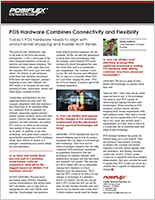Posiflex White Papers
The Importance of HALT/HASS Testing for POS
So, you may be wondering, "What is HALT/HASS, why should I care, and how does this affect point of sale?" The HALT/HASS process is a series of rigorous tests that expose devices to environmental stresses that are far beyond what would be expected during even the most rugged everyday use. Some companies design their POS systems to attain a price point. The best products are designed and manufactured—with the help of HALT and HASS testing—to a commitment to quality and durability. Posiflex products are HALT/HASS certified, and are built to overperform to ensure a longer total cost of ownership.
VIEW WHITE PAPER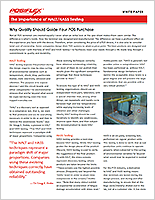
Order Kiosks Prove to Be One Solution for Labor Shortage
Restaurateurs are struggling harder than ever to find and retain good employees. According to some accounts, turnover rates in U.S. restaurants are as high as 150 percent annually. It’s not surprising that customer-facing order kiosks are becoming increasingly popular options to offset labor challenges. Using automated kiosks, customers can place their own orders and pay for them without employee assistance. Staff is then freed up to focus more on food and direct customer service. Posiflex Business Machines, a leading manufacturer of order kiosks and POS terminals for the foodservice industry, is introducing a new line of customer-facing terminals that enables restaurant guests to order for themselves. Doyle Ledford, vice president of sales for the Hayward, Calif.-based company, spoke with Nation’s Restaurant News about the positive impacts increased kiosk use are making on restaurants.
VIEW WHITE PAPER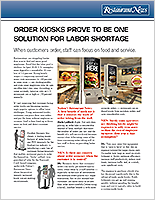
POS System Durability Is a Must for Restaurants
In most workplaces, people treat computers as fragile devices needing some TLC to operate correctly. And then there’s the restaurant industry, where computerized POS terminals get no such love when: hurried servers can treat touch-screens more like “poke screens.” ; humidity and salt air accelerate component corrosion on POS terminals placed outside; in cramped, cluttered server stations, terminals get banged up as rushed servers maneuver for silverware and plates in tight spaces. That describes an ordinary day for POS terminals at Duffy’s Sports Grill. According to Meghan Clausell, director of IT at the 34-unit Lake Worth, Fla., chain, it’s expected that POS terminals will get roughed up by employees pressured to please customers quickly, as much as owners don’t like it.
VIEW WHITE PAPER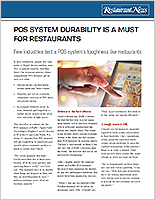
POS Systems Help Solve Labor Problems
Since labor turnover in restaurants is a never-ending battle, training new employees remains an ongoing challenge for busy operators. Teaching consistent standards to new team members becomes even more difficult when using an outdated POS system — or none at all. That’s why it’s virtually essential to have a modern POS system that’s not only durable and intuitive, but also teachable to all employees, whether in a single restaurant or across a large chain. Service uniformity and long-term profitability depend on it.
VIEW WHITE PAPER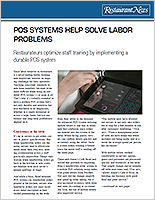
5 Ways to Make the Most of Your POS System
A point-of-sale system is an invaluable tool for running a modern restaurant. From its most basic function of taking orders rapidly and accurately, to its highest utility of providing crucial insights into sales and labor data, these high-tech devices do nearly everything outside of cooking the food and preparing the drinks. Unfortunately, operators sometimes fail to maximize the many features of their POS systems. Others even purchase the wrong one — devices ill-suited to the environment in which they’re used, or unable to deliver the level of performance a specific operation requires. To alleviate both problems, here are five basic ways restaurant operators can get the most out of their POS systems, from deciding which to purchase
VIEW WHITE PAPER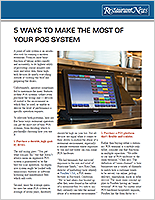
The Importance of Having a Durable, Reliable POS System
If point-of-sale terminals were human, they’d probably hate life in a restaurant industry. Buffeted by their use in hot, greasy kitchens, accidental spills in bars and harried, heavy-fingered servers banging in rushed orders, these high-tech order processors must withstand far more abuse than computerized order processors in other industries. Consequently, their hardware can break down under such stress, requiring expensive repairs and costly downtime that reduces a busy staff’s productivity and a restaurant’s sales.
VIEW WHITE PAPER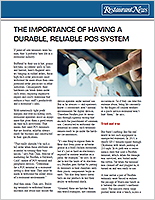
How the Power of Partnership Created a Self-Registration Kiosk Solution
Health Management Technology Magazine (HMT) followed a group of companies that came together as a Consortium to present their services, solutions, and processes as they directly relate to real-world problems.They developed a check-in solution greater than the sum of its parts that included efforts from the Consortium that included: Posiflex, Clearwave, IMG-Imaging Manufacturing Group, and MedicScan. HMT followed the story of how one of their customers, Baptist Health, implemented this endeavor and the success they had as the kiosk solution created all types of efficiencies for their cancer center that included increased patient satisfaction, check-in time savings, increase data accuracy and revenue cycle opportunities.
VIEW WHITE PAPER
The Move to the Omni-Terminal POS
The omichannel world continues to change the breadth of retailing, and stores must learn to adapt. As retailers explore how to implement evolving business concepts as a means to stay relevant in an always-on business environment, they must move beyond traditional point-of-sale (POS) systems toward the next-generation “omni-terminal.”
VIEW WHITE PAPER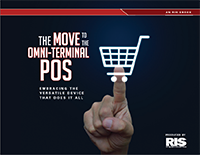
A Bold New (Technology) World for C-Store Retailers
In today’s consumer-focused marketplace, traditional, stationary POS stations are functionally obsolete and they are an inefficient footprint. Conversely, the POS of the future needs to be flexible and functionality-advanced. This requires a hybrid solution that can be used as a stationary device, a mobile device, even a self-service device for employee-assisted or customer directed functionality.
VIEW WHITE PAPER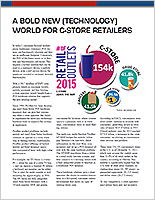
How POS Hardware Drives C-Store Innovation
Innovation should be the driving factor behind sales growth for today’s convenience store operators, and having the right kind of POS hardware tools could mean the difference between sales success or failure. With an eye on customer engagement and flexibility, c-store, truck stop and gas station operators of all shapes and sizes should explore how to adopt next-generation POS devices.
VIEW WHITE PAPER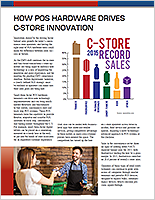
Tablet Technology Bridges Hospitality, Customer Engagement
Restaurant executives looking to reduce theft, improve employee productivity and increase the guest experience have been rolling out hybrid tablet POS terminals throughout their locations. The tablets serve as a dual-function POS system, giving adults the ability to order food and drinks, and children access to games.
VIEW WHITE PAPER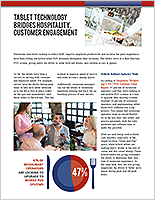
Tablet Technology In Retail for Improved Customer Experience
A lot has changed for consumers in the past 20 years. Not only has their retail purchasing and buying power shifted, so too has how they gather product information and pay for their purchases. Today’s consumers are looking for richer shopping experiences through more personalized service and rewards. This makes each and every transaction an important component of retail customer loyalty and service.
VIEW WHITE PAPER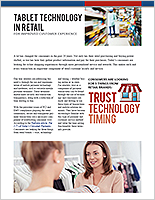
Tablets Are Critical Point of Service Devices in Hospitality
In the restaurant environment, tablets have a dual-mode capability that is ideal for performing critical elements of service that improve server productivity and customer satisfaction. Read how the Director of IT for Hooters America, Wes Marco, uses tablets to increase productivity and maximize efficiency for the Hooters chain of restaurants.
VIEW WHITE PAPER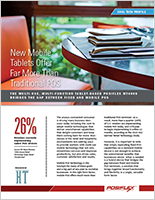
Retailers Want Mobile POS to Drive Sales and Deliver ROI
The unique thing about tablet technology is that it brings the benefits of POS and enterprise applications to the customer instead of the other way around. This benefit not only increases the speed of service, but it adds convenience and a level of personal engagement that produces more delighted and loyal shoppers. To meet customer demands, retailers are speeding up the pace of their traditional business models by doing more frequent store sets, creating unique shopping environments on sidewalks, and modifying prices, product assortments and signage on the fly.
VIEW WHITE PAPER
New Mobile Tablets Offer Far More Than Traditional POS
The always-connected consumer is driving many business decisions today including the rush to adopt mobile technologies that deliver omnichannel capabilities that delight customers and keep them coming back for more. Businesses in the retail and hospitality environments are seeking ways to provide workers with multi-use mobile technology that not only streamlines services and improves productivity, but also drives sales, customer satisfaction and loyalty.
VIEW WHITE PAPER
Tackling Next-Gen Payment
What’s top of mind for most retailers? A POS that can enable the organization to accept new mobile payment options, and that will take the EMV migration in stride. In fact, both retailers and suppliers agree that the ability to accept mobile wallet has had a significant impact on POS software purchasing decisions, as has EMV-readiness and overall payment security with the October 2015 deadline quickly approaching.
VIEW WHITE PAPER
POS in the Palm of Your Hand
The checkout is the final touchpoint in the shopper journey and savvy retailers are upgrading their POS hardware to improve both the customer experience and back-room functionality. As retailers look to modernize their POS offerings they are increasingly opting for systems with mobile capabilities. Mobile POS allows for greater customer/associate interaction while simultaneously portraying a cool and hip vibe on the show floor. Whether it is new-age mobile or traditional fixed location offerings, a host of new POS options are changing the face of retail.
VIEW WHITE PAPER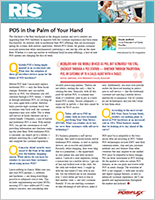
The Most Important Considerations for Purchasing POS Terminals
When budgeting is tight, every dollar is scrutinized. In this environment, it is understandable why so many companies look at the price of acquisition of POS (point of service) terminals first when considering what to upgrade for their customer transactions.
VIEW WHITE PAPER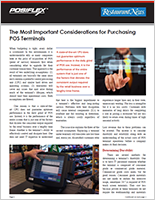
How Much Is Your POS Really Costing You?
In this paper, POS industry experts interviewed ISV and VAR solutions providers who have changed their service and support strategies with significant bottom line results. This hypercompetitive, always-active retail environment demands POS systems continuously operate at full capacity.
VIEW WHITE PAPER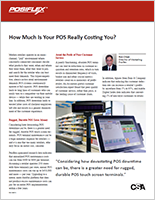
Choosing Your POS System: Quality and Why it Matters
POS devices are everywhere, and they frequently represent mission critical devices because of how tightly integrated they are with an organization’s line of business. This analysis looks at why quality should be at the top of the list whenever making a POS buying decision, because quality is what provides the durability and resilience that translates into years of trouble-free use—and hence a lower total cost of ownership.
VIEW WHITE PAPER
How Do You Know If It’s Time to Upgrade Your POS System?
Rapid advances in omnichannel technology in the past several years have radically changed the nature of POS. Instead of serving as simple transaction execution devices, POS systems now serve as links to a customer’s loyalty and behavioral history across all channels. In many instances, POS platforms also need to extend to mobile and customer self-service devices, connect to social networks and otherwise extend beyond standard fixed terminals.
VIEW WHITE PAPER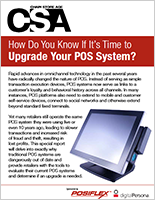
POS Hardware Combines Connectivity and Flexibility
Today’s POS hardware needs to align with omnichannel shopping and mobile tech trends. The point-of-sale, traditionally seen as the heart of the brick-and-mortar environment, is still a critical part of the store shopping experience in the age of mobility and omnichannel shopping. The difference today is that, more than ever, the stationary POS must “play well with others” for retailers to get maximum value from their hardware investment.
VIEW WHITE PAPER